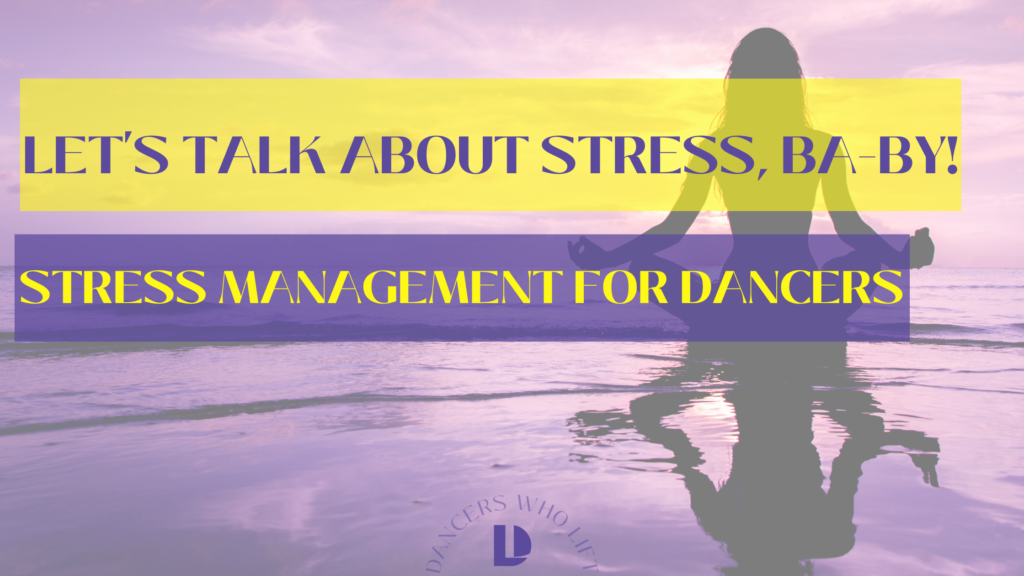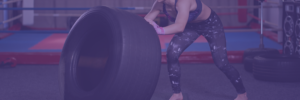Let’s imagine for a moment that it’s mid-audition season, and you’ve been hustling.
Callbacks have been generous, which is great, but it’s also created a lot to juggle.
You’ve had to cancel work shifts, find readers for self-tapes, and despite all of this hard work, you’re watching friend after friend bookwork while you’re still hustling.
That is a lot of stress to manage.
Auditions are physically and mentally, and emotionally stressful. They require you to have full command of your body, a clear mind, and a stable emotional state. Auditions alone are enough to require good stress management skills. Add to that the need for the mental and emotional capacity to cancel or reschedule work and the emotional fortitude to celebrate your friends’ wins while you are still hoping for a win of your own; and you have a recipe for a body that is stuck in stress mode. That’s why stress management for dancers is so important.

Even if you aren’t in a season of auditioning, balancing workouts, dance classes, work, and social life can be incredibly overwhelming. When our lives get this full our bodies have a hard time coming out of “fight or flight” mode and we can end up living in a state of constant stress. Sometimes we don’t even realize we are stuck in this place because it becomes the norm. That’s why prioritizing rest days is so incredibly important. It helps us escape stress mode and return our bodies to homeostasis. How do we do that? By learning stress management as dancers. Because some stress, like the stress we put on our muscles to lift weights or the stress of an impending deadline, is helpful. It motivates us to get things done and gives us the energy to push through tough situations.
So, you might be asking,
“If stress helps to keep us motivated, why is it so bad? Don’t some people have a higher capacity for it than others?”
While it is true that some people have a higher threshold for what puts their bodies into fight or flight, it’s also true that no one’s body is designed to be in fight or flight constantly. This is because fight or flight mode releases a hormone called Cortisol. Cortisol enhances our brain’s use of glucose, and it increases the substances that help rebuild tissues in the body. However, Cortisol also limits the functions of the body that are considered “non-essential” by altering immune responses, suppressing the digestive system and the reproductive system, and slowing the growth process in our bodies. It also, and maybe most importantly, works with the part of the brain that controls mood, motivation, and fear. That’s why it’s not uncommon for people living in a constant state of stress to have heightened levels of anxiety and depression.

The good news is, there are a lot of tools available to us to help us with stress management. The first tool I want to tell you about is by far the most convenient because it’s always readily available to you. It is to simply breathe.
1. Simply Breath
When we feel stressed, the first thing that changes in us physiologically is our breathing. When stressed or anxious, you may notice your breath becoming shorter and shallower, or, some people hold their breath when they are stressed or anxious. Either way, the answer is to take deep, long breaths. Consecutive, controlled, deep breaths enlist our parasympathetic nervous system to stimulate relaxation and encourage your body to return to equilibrium; and as a result, you’ll take in more oxygen and your heart rate and mind will start to slow down.
Go ahead and try it right now:
Breathe in through your nose until you can’t fit any more air in. Then, slowly exhale as if you are blowing through a straw, as slow and controlled as possible. Repeat that for a total of six to ten times.
Try this whenever you feel overwhelmed or stressed to support your body rather than fight against anxiety.
The next thing you can try when you feel stressed is exercise!
2. Exercise.
Now, before you get excited, I want to say, be careful with this one. If you’ve had a crazy active week with multiple classes and auditions, and workout sessions, maybe opt for an activity centered around mindfulness to help your body find some rest despite the stress. But it is true that when we are feeling stressed, movement is an excellent outlet for stress. Not only does it give you an endorphin boost but movement also helps our bodies reset and focus on something new. It doesn’t have to be much, a short walk around the block or a ten-minute yoga flow in your living room will help immensely in moving that negative energy out of your body.
3. Go outside.
Connecting with nature, feeling the sunshine on your skin, and breathing fresh air, it’s all going to help. Something about simply being outdoors, looking at the clouds, or walking through a park, helps us remember that the world is bigger than we are. And when we realize what a big beautiful world we are a part of, we are able to look at our lives with fresh perspective. If you can’t get outside, try walking over to a window, look at the sky or the trees, and take those big deep breaths; just remember that there is a world beyond the walls you’re sitting within.
The next tool for your “destress toolbox” is sleep.
4. Sleep.
Getting quality sleep is the secret ingredient to improving your overall well-being. You’ve heard us talk about quality sleep as a way to promote faster muscle recovery and speed your progress toward your health goals, but it is also an important part of destressing. When we sleep, our brains continue processing the things weighing on our minds. New mental maps are formed, and memories are transferred from short-term to long-term. Better sleep will help you perform better in all aspects of your life. So how can we ensure we set ourselves up for a good night’s rest?
Create a bedtime routine.
Dim the lights in your room, maybe light some candles-make your space feel cozy and relaxing to you. One of the hardest things to do that can make the biggest difference is turning off all electronics thirty minutes before bedtime. I’ve started replacing that with reading a book or even making a bedtime cocktail while I reflect on the day.
What’s a bedtime cocktail?!
I’m so glad you asked! It’s a drink that is made of natural ingredients that promotes relaxation. My favorite is 100% Tart Cherry juice! It’s a great calming agent to help you prep for bedtime because it contains naturally occurring tryptophan and melatonin, making it the perfect evening beverage! Just mix it with your favorite sparkling water, pour it into a fancy glass, and enjoy something to sip on. This is especially helpful when I’m in the mood for a glass of wine but want to avoid consuming alcohol.

5. Meditation
Meditation is another fantastic tool for managing stress. It allows you to quiet your mind and notice your thoughts, helping you slowing down the racing thoughts often triggered by fight or flight mode. If you’re new to meditation, there are a couple of apps that can guide you into a meditative space. My first recommendation is “Headspace.” This app not only has guided meditations but offers courses and information about stress and stress management. The next is “Shine.” This is designed as a podcast-style meditation so you can put in your headphones, tune out the world, and tune into the meditative space. And finally, there is the calm app. A bonus about this app that they have guided breathing exercises and podcast-style bedtime stories as well as meditations to help you relax and ease into a breathing routine, fall asleep, or meditate.
These last two tips for reducing stress may seem trivial, but they actually help a great deal. The first one is to get yourself laughing.
6. Laughing.
Laughing will reset your system and give your brain a break from worry. So, look up your favorite comedian, watch a feel-good, funny movie, or call up your friend that always has the best stories and has a big old laugh! And when you’ve finished laughing, do one of your favorite hobbies.
7. Try a hobby.
The things you enjoy, like crafting, baking, or playing an instrument, are the things that make you, you. Spending time doing those activities will bring you back to who you are and, again, remind you that there is so much more to your life than the situations bringing you stress.
I know this seems like a lot, but it doesn’t have to be. Start by picking just one tool to add to your routine and see if it helps. Then, you can slowly add the others to your arsenal as you’re ready. And a bonus? Stress management for dancers will also help promote faster recovery between training and performances! The most important thing is finding what works for you so that you can live a life that doesn’t have you constantly stressed out. And it will take practice, but I promise you won’t regret it.
xox
DWL TEAM





















 Performing on a cruise ship is a pretty sweet gig.
Performing on a cruise ship is a pretty sweet gig.












